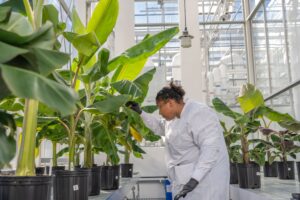 … Matt DiLeo, Elo’s vice president for product development with a Ph.D. in plant pathology, told me as we began touring the facility that the company’s work on the Cavendish began in 2020. Aware of the threat TR4 posed, it reached out to Dole about forming a partnership. He guided me to a wing that houses the startup’s growth chambers—sterile white rooms whose 82F temperature is maintained by long, cylindrical overhead heat lamps. The air inside was sticky, vicariously transporting me to the Latin American fields where bananas are grown. Transparent plastic containers, each one bar-coded, were spread among three shelves along one wall. Sealed inside each was a tiny banana shoot sitting in a chemical medium of nutrients and hormones to nurture minuscule roots.
… Matt DiLeo, Elo’s vice president for product development with a Ph.D. in plant pathology, told me as we began touring the facility that the company’s work on the Cavendish began in 2020. Aware of the threat TR4 posed, it reached out to Dole about forming a partnership. He guided me to a wing that houses the startup’s growth chambers—sterile white rooms whose 82F temperature is maintained by long, cylindrical overhead heat lamps. The air inside was sticky, vicariously transporting me to the Latin American fields where bananas are grown. Transparent plastic containers, each one bar-coded, were spread among three shelves along one wall. Sealed inside each was a tiny banana shoot sitting in a chemical medium of nutrients and hormones to nurture minuscule roots.
These are the modified plants, and Elo propagates many identical shoots from each one. Some have outside genes inserted into their DNA; others possess a version of their original genome that’s been modified to tell the plant to express a specific protein. To test whether the baby plants show signs of resisting TR4, Elo’s scientists remove the shoots, dip them into a solution of fungal spores and plant them in soil in a separate growth chamber. “Then it takes 13 days to either kill the plants or not,” DiLeo said.
The Cavendish contains more than 30,000 genes, exceeding the 20,000 or so found in a human, but Elo’s scientists are studying only about 100 targets. Some are Cavendish genes that might be switched on or off to kick-start a disease response; some are genes from other bananas that might confer resistance. Elo arrived at those targets by identifying differences between the Cavendish genome and the genomes of TR4-resistant bananas and related species, such as plantains. Find a distinction, and you may find the gene that could protect the Cavendish. The work took about three years and a good deal of computational biology.
Read the full article